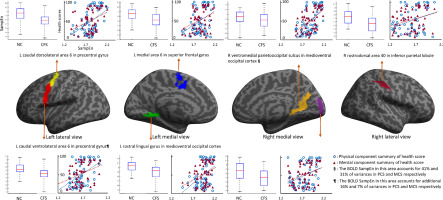Murph
:)
- Messages
- 1,799
https://www.sciencedirect.com/science/article/pii/S2213158218301347
Brain function characteristics of chronic fatigue syndrome: A task fMRI study
Author links open overlay panelZack Y.ShanaKevinFineganbSandeepBhutabTimothyIrelandbDonald R.StainesaSonya M.Marshall-GradisnikaLeighton R.Barndena
Highlights
•
CFS patients recruit larger BOLD activation areas for the Stroop task.
•
BOLD signal complexities in CFS are lower in ten activated regions while complexities of heart rate and pulse pressure are similar.
•
The BOLD signal complexity is correlated with the SF-36 health score across all subjects.
•
The BOLD signal complexity explains more than 40% of variance in the health score across all subjects.
Abstract
The mechanism underlying neurological dysfunction in chronic fatigue syndrome/myalgic encephalomyelitis (CFS/ME) is yet to be established. This study investigated the temporal complexity of blood oxygenation level dependent (BOLD) changes in response to the Stroop task in CFS patients.
43 CFS patients (47.4 ± 11.8 yrs) and 26 normal controls (NCs, 43.4 ± 13.9 yrs) were included in this study. Their mental component summary (MCS) and physical component summary (PCS) from the 36-item Short Form Health Survey (SF-36) questionnaire were recorded. Their Stroop colour-word task performance was measured by accuracy and response time (RT). The BOLD changes associated with the Stroop task were evaluated using a 2-level general linear model approach. The temporal complexity of the BOLD responses, a measure of information capacity and thus adaptability to a challenging environment, in each activated region was measured by sample entropy (SampEn).
The CFS patients showed significantly longer RTs than the NCs (P < 0.05) but no significant difference in accuracy. One sample t-tests for the two groups (Family wise error adjusted PFWE < 0.05) showed more BOLD activation regions in the CFS, although a two sample group comparison did not show significant difference. BOLD SampEns in ten regions were significantly lower (FDR-q < 0.05) in CFS patients. BOLD SampEns in 15 regions were significantly associated with PCS (FDR-q < 0.05) and in 9 regions were associated with MCS (FDR-q < 0.05) across all subjects. SampEn of the BOLD signal in the medioventral occipital cortex could explain 40% and 31% of the variance in the SF-36 PCS and MCS scores, and those in the precentral gyrus could explain an additional 16% and 7% across all subjects.
This is the first study to investigate BOLD signal SampEn in response to tasks in CFS. The results suggest the brain responds differently to a cognitive challenge in patients with CFS, with recruitment of wider regions to compensate for lower information capacity.
Graphical abstract
The sample entropy (a measure of amount of information encoded in a temporal signal) of BOLD response to Stroop tasks in seven areas are significantly lower in patients with chronic fatigue syndrome (CFS) and significantly correlated health scores across all subjects, suggesting that the brain operates differently in CFS patients.

Brain function characteristics of chronic fatigue syndrome: A task fMRI study
Author links open overlay panelZack Y.ShanaKevinFineganbSandeepBhutabTimothyIrelandbDonald R.StainesaSonya M.Marshall-GradisnikaLeighton R.Barndena
Highlights
•
CFS patients recruit larger BOLD activation areas for the Stroop task.
•
BOLD signal complexities in CFS are lower in ten activated regions while complexities of heart rate and pulse pressure are similar.
•
The BOLD signal complexity is correlated with the SF-36 health score across all subjects.
•
The BOLD signal complexity explains more than 40% of variance in the health score across all subjects.
Abstract
The mechanism underlying neurological dysfunction in chronic fatigue syndrome/myalgic encephalomyelitis (CFS/ME) is yet to be established. This study investigated the temporal complexity of blood oxygenation level dependent (BOLD) changes in response to the Stroop task in CFS patients.
43 CFS patients (47.4 ± 11.8 yrs) and 26 normal controls (NCs, 43.4 ± 13.9 yrs) were included in this study. Their mental component summary (MCS) and physical component summary (PCS) from the 36-item Short Form Health Survey (SF-36) questionnaire were recorded. Their Stroop colour-word task performance was measured by accuracy and response time (RT). The BOLD changes associated with the Stroop task were evaluated using a 2-level general linear model approach. The temporal complexity of the BOLD responses, a measure of information capacity and thus adaptability to a challenging environment, in each activated region was measured by sample entropy (SampEn).
The CFS patients showed significantly longer RTs than the NCs (P < 0.05) but no significant difference in accuracy. One sample t-tests for the two groups (Family wise error adjusted PFWE < 0.05) showed more BOLD activation regions in the CFS, although a two sample group comparison did not show significant difference. BOLD SampEns in ten regions were significantly lower (FDR-q < 0.05) in CFS patients. BOLD SampEns in 15 regions were significantly associated with PCS (FDR-q < 0.05) and in 9 regions were associated with MCS (FDR-q < 0.05) across all subjects. SampEn of the BOLD signal in the medioventral occipital cortex could explain 40% and 31% of the variance in the SF-36 PCS and MCS scores, and those in the precentral gyrus could explain an additional 16% and 7% across all subjects.
This is the first study to investigate BOLD signal SampEn in response to tasks in CFS. The results suggest the brain responds differently to a cognitive challenge in patients with CFS, with recruitment of wider regions to compensate for lower information capacity.
Graphical abstract
The sample entropy (a measure of amount of information encoded in a temporal signal) of BOLD response to Stroop tasks in seven areas are significantly lower in patients with chronic fatigue syndrome (CFS) and significantly correlated health scores across all subjects, suggesting that the brain operates differently in CFS patients.

